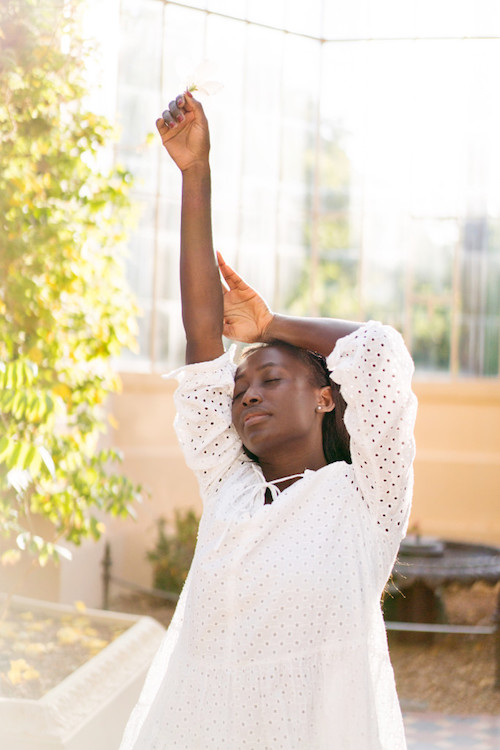Breathwork: How To Reduce Stress With Breathing Exercises
By Radiant Health | Words by Oreoluwa Ogunyemi, MDPublished: November 13, 2021
This piece was first published in Radiant No. 16, The Self Care Issue. Now on Newsstands.
Most of us don’t give a second thought to our breathing. After all, we’ve been breathing since birth; why work on something we’ve done automatically all our lives? While breathing is an automatic function, if we dig a little deeper we’ll find that mindful breathing is not only necessary for survival but integral to our well-being.
Why Breathwork?
Breathwork refers to a range of practices that bring focused attention to breathing in order to promote health. While there has been an evolution of New Age therapies with unproven claims, breathwork has been around for millennia. Prāṇāyāma, as it is known in the yogic tradition, translates to “expansion of the life force,” summing up the value of breath in our lives.
Think of the breath control of opera singers or the efficient breathing cadence of marathoners and you’ll get a sense of how much breath affects our lived potential. On the other hand, consider the heavy smoker’s struggle for breath, or even yourself after suddenly sprinting to catch a bus, and you’ll also be aware of how breathlessness can take away our vital energy.
As we tune into our breath, we rediscover the richness and depth of each moment and each breath that we are fortunate enough to take in.
Mindful Breathing
Ancient yogis like Patanjali believed that breath control was a prerequisite for meditation and even enlightenment. While modern research may not go so far as enlightenment, there is good evidence that breathing can be a key to unlocking one’s physical and mental well-being.
We know that deep, resonant breathing that starts in the belly and engages the diaphragm activates the parasympathetic nervous system (PNS). The PNS is a network of nerves that promote rest, relaxation, and digestion. Conversely, the sympathetic nervous system (SNS) is the fight or flight system we fall back on during stressful times.
By activating our PNS through our breath, we affect our heart rate, blood pressure, and even our ability to digest nutrients. Consciously learning to slow down and take deep belly breaths has been shown to decrease blood pressure and heart rate in as little as five minutes. That action compounds over time as the repeated engagement of the PNS through breathing crowds out the chronic stressors of the modern world.
Evidence suggests that both children and adults with an active PNS lower their risk for heart disease, high blood pressure, anxiety, and depression. Slow and shallow breathing can do the opposite. The locus coeruleus (LC)—an area of the brain tied to arousal and attention—is connected to the brain’s breathing control center. The LC is a storehouse of noradrenaline, a brain chemical that drives the fight or flight response.
In one study, mice without a direct connection between the breathing center and the LC were perpetually calm: they took slower breaths and focused only on grooming behaviors and quiet sitting. The connection between the breathing center and the LC probably evolved to boost alertness when we become low on oxygen. Yet even as we are boosted by smaller and quicker breaths, this can lead to chronic anxiety and even panic if we don’t learn to turn off the adrenaline rush.
There is also evidence that an active PNS is critical for a well-functioning brain. The PNS has extensive connections with the prefrontal cortex of the brain, indicating that our ability to relax affects how well we complete complex mental tasks. Studies show that people with an active PNS are more able to focus their attention, make complex plans, and perform better on memory tasks.
RELATED: 6 Steps to Stress-Free Living and Mental Wellness
What Should I Know Before Starting Breathwork?
Breathwork is one of the simplest and safest treatments you can try. Unlike anxiety medications that can have long-lasting side effects or therapy sessions that can leave a hole in your pocket, breathing is available to you whenever and wherever you want it.
You may initially feel a bit anxious or even lightheaded when beginning breathwork, especially if you hold the breath for too long or proceed too quickly in slowing the breath. In modern times a rate of 12 to 20 breaths each minute is considered normal, yet in many yogic breath practices a rate closer to six breaths per minute is needed to tap into the PNS.
Rather than focusing on speed, work your way up to breath retentions and slowed breathing in a compassionate way. Try to let go of rigidly “controlling” your breath, but focus instead on an awareness and deepening of the breath.
Incorporating Breathwork into Daily Life
Breathwork doesn’t have to take up a lot of your time. It is a simple tool that allows you to breathe in calmness right when you notice stress rising. If you want to dive deeper, start with a minute or two each day and slowly work your way up to a your version of a full daily practice. For many, this is 20-30 minute practice, while others with the time will choose to practice for an hour or longer.
Here are three breath styles you can try:
4-7-8 Breath Popularized by Dr. Andrew Weil, this technique uses breath retention and longer exhales to tap into the rest and digest part of the brain.
To practice: Sit up tall with a straight spine. Exhale fully. Slowly inhale through your nose over a count of four. Then, hold your breath for seven counts. Finally, exhale fully through your mouth for eight counts. To begin, try to complete four breath cycles and slowly work up to eight cycles.
Bumblebee Breath (Bhrāmarī Prāṇāyāma) This breathwork technique focuses on a long humming exhalation to achieve relaxation. It may also help manage asthma and tinnitus (persistent ringing in the ears).
To practice: Sit up tall with a straight spine. If you choose to, you can cover your eyes with your fingers and plug your ears with your thumbs (this helps keep your focus on the breath). Inhale through the nose. Exhale slowly while making a humming (or “mmmm”) sound. Try to do three to four breath cycles at a time.
Alternate Nostril Breathing (Nāḍi śodhana) This yogic breathwork alternates breathing between the two nostrils to bring the opposing activating and calming aspects (SNS and PNS) into balance.
To practice: Sit up tall with a straight spine. Make a loose fist with your right hand and extend the thumb and the pinky and ring fingers (this is the Vishnu mudra). Exhale fully, then block your right nostril with the thumb and inhale through the left nostril. Next block your left nostril with the pinky and ring fingers as you exhale through the right nostril. Keeping the fingers as they are, inhale right. Block the right nostril and release the left nostril to exhale out the left. Keep the fingers as they are to inhale left. Alternate back and forth using the pinky and ring finger to block the left nostril and the thumb to block the right. You always begin practice inhaling through the left nostril and end exhaling through the left nostril. Slowly work your way up to a practice of five minutes or longer.
Breathing shouldn’t simply be an automatic survival habit devoid of awareness. By slowing and deepening our breath we can invite a calming force into our day, right when we need it the most. Try one or all of these and open up to all your breath has to offer.
This piece was first published as Learning to Exhale: The Benefits of Breathwork in Radiant No. 16, The Self Care Issue. Now on Newsstands.
Like what you're reading? Sign up for our free newsletter and never miss a post! Plus get a FREE digital version of our Issue No.10 with sign up.

- 11 Best Health and Wellness Books to Read in 2024 - July 4, 2024
- Some Americans Will Have Medical Debt Wiped From Credit - July 9, 2022
- Natural Gas Used to Heat Homes Contains Some Harmful Chemicals - July 9, 2022
- Uterine Cancer Claims Many Black Lives - July 9, 2022
- Babies and Toddlers Get COVID-19 Shots - June 27, 2022
- FDA Bans Juul’s E-Cigarettes and Cartridges - June 27, 2022
- Polio Virus Found in London Sewage - June 27, 2022
- 200 Million Americans Are Drinking Contaminated Water - June 19, 2022
- Young Kids Can Finally Get Vaccinated Against COVID-19 - June 19, 2022
- New Regulations for Baby Sleep Products - June 19, 2022












